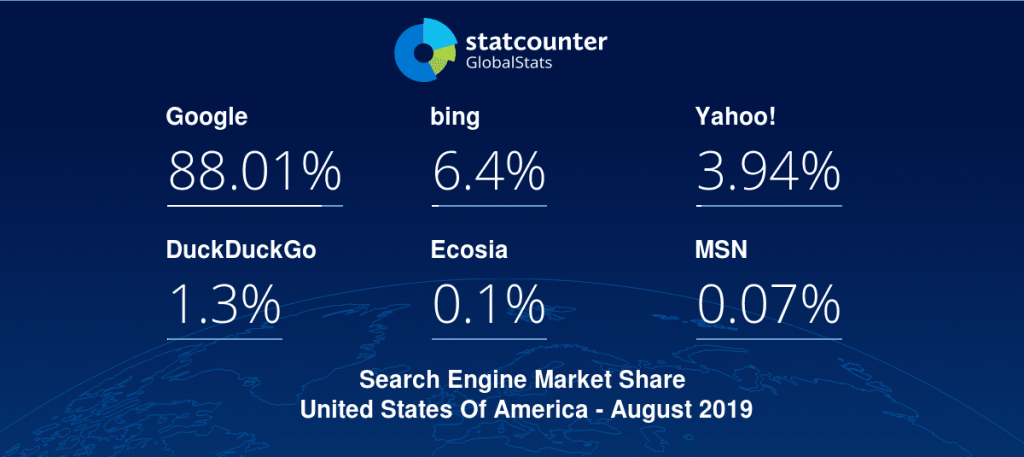Bing Traffic: What Do You Lose If You Ignore It?
Everyone knows Bing has essentially lost the war against Google. Google is leaps and bounds more popular but that doesn’t mean Bing traffic can just be ignored. Like any platform, Bing has its own customer demographics, and you may find Bing traffic has more in common with your products and services than Google does. Bing Ads can still be worthwhile, especially when trying to broaden your audience base. Here’s what you need to know.
Bing vs. Google: A Matter of Market Share
90% of all searches happen on Google, Google Images, or Google Maps. Bing accounts for 1.48% of all web searches. That’s not a lot. When you look at that in totality, it seems as though you might as well concentrate on Google. And most people do.
But that doesn’t mean using Bing isn’t a viable strategy, it just means it isn’t a broad one. There are still people using Bing, and Bing advertising is still valuable. The market share just means you shouldn’t rely only on Bing: you should be running Google campaigns as well.
Even if only 1.48% of web searches occur on Bing, that’s still hundreds of millions of searches. These are all opportunities for businesses, especially businesses which work primarily in eCommerce.
A Big Fish in a Small Pond
Bing has much less competition than Google and everyone is advertising on Google. There’s a huge amount of market saturation. But on Bing, fewer players mean it’s a more even market. You can build a following and a reputation faster on Bing. And in the world of eCommerce, that matters.
Of course, brick-and-mortar retailers may not find this as useful. Brick-and-mortar retailers need to go where the audience is. On Google, there may be 900 people in their advertising range. On Bing, there might only be 9. Meanwhile, for an eCommerce retailer, advertising “ranges” don’t matter at all; anyone, anywhere is fair game.

Cost-Effective Online Marketing
Bing is a fraction of the cost of marketing through Google. Let’s say you have $1,000 to spend. You may be able to advertise to a small percentage of Google’s audience: 10,000 people. But with that $1,000, you can advertise to 50,000 people in Bing’s audience. Even if Bing’s audience itself is smaller, your reach as a brand is larger, because you’re able to reach more of them.
If you’re looking to stretch your advertising dollar, Bing just makes sense. You don’t need to go to the place that has millions upon millions of individuals, because you (likely) don’t have the advertising dollars to reach all of those individuals. And you don’t need to. All you need to do is reach as many individuals as you can within your budget.
Who is Using Bing?
Bing is used by Amazon’s Alexa and Microsoft’s Cortana and anyone with an Alexa or a Microsoft Phone is going to automatically search through Bing. That’s not trivial, especially for companies specializing in online retail, as many people look up products through their smart devices.
But apart from that, you could find an audience on Bing that suits your products or services better.
Bing users:
• Tend to be older, in the 55 to 65 demographics. Baby boomers are more likely to use Bing, as they are less likely to change their default browser.
• Tend not to care too much about technology, but still use it. Often, they haven’t changed their default web browser. This isn’t necessarily because they don’t know how, but rather because they aren’t interested in doing so.
• Tend to be high in value. 33% of Bing’s audience makes more than $100,000 per household.
• Tend to spend more online. This is the most important factor. Bing users tend to spend over 20% more than other users on eCommerce sites.
What does this mean? People who are using Bing are more likely to make a purchase. It also means that they are older, which comes with separate challenges.
Is Bing Traffic Important to Your Business?
Any business should experiment with both Google and Bing. A/B testing will easily show you whether one platform is more valuable than the other. There are many compelling reasons why Bing can be better for a business than Google, even if Google is widely considered to be the superior search engine.
If you’re targeting individuals who are older, or if you’re looking to make eCommerce sales globally, Bing is an important addition to your marketing strategy. Your advertising dollar may go further in Bing, and Bing could grant you access to a demographic more likely to make purchases.
If you’re primarily targeting a younger audience, Bing might not be the right solution. Bing traffic can still give you a boost and Bing Ads may still be valuable but they may not be as valuable as if you were targeting older individuals.
What You Need to Know About Bing Ads
If you know Google Ads, you know Bing Ads. The platform and advertising structure are almost identical because it means you can transition from one platform to another with ease. If you’re already doing Google Ads, there isn’t a significant amount of information you’ll need to get started on Bing Ads, too.
Over time, you’ll be able to see the differences in your statistics from Google Ads and Bing Ads. Running identical campaigns on both platforms will tell you what you need to know about which campaign is more effective and which demographics are looking at your ads.
Bing traffic may not be as large as Google traffic but it still can be valuable. It depends on your demographics, your type of business, and your business goals. As with any marketing tactic, it’s often best to cast a wide net. If you want to augment your existing marketing campaign, creating Bing ads can be an excellent and cost-effective channel. Since Bing Ads are so much more affordable than Google Ads, you can spend a considerable amount of time experimenting and finding out what works best. Ultimately, advertising is advertising: the more advertising you do, the better your ROI should be.
Contact us for more on how Colling Media helps businesses take advantage of Bing advertising.
